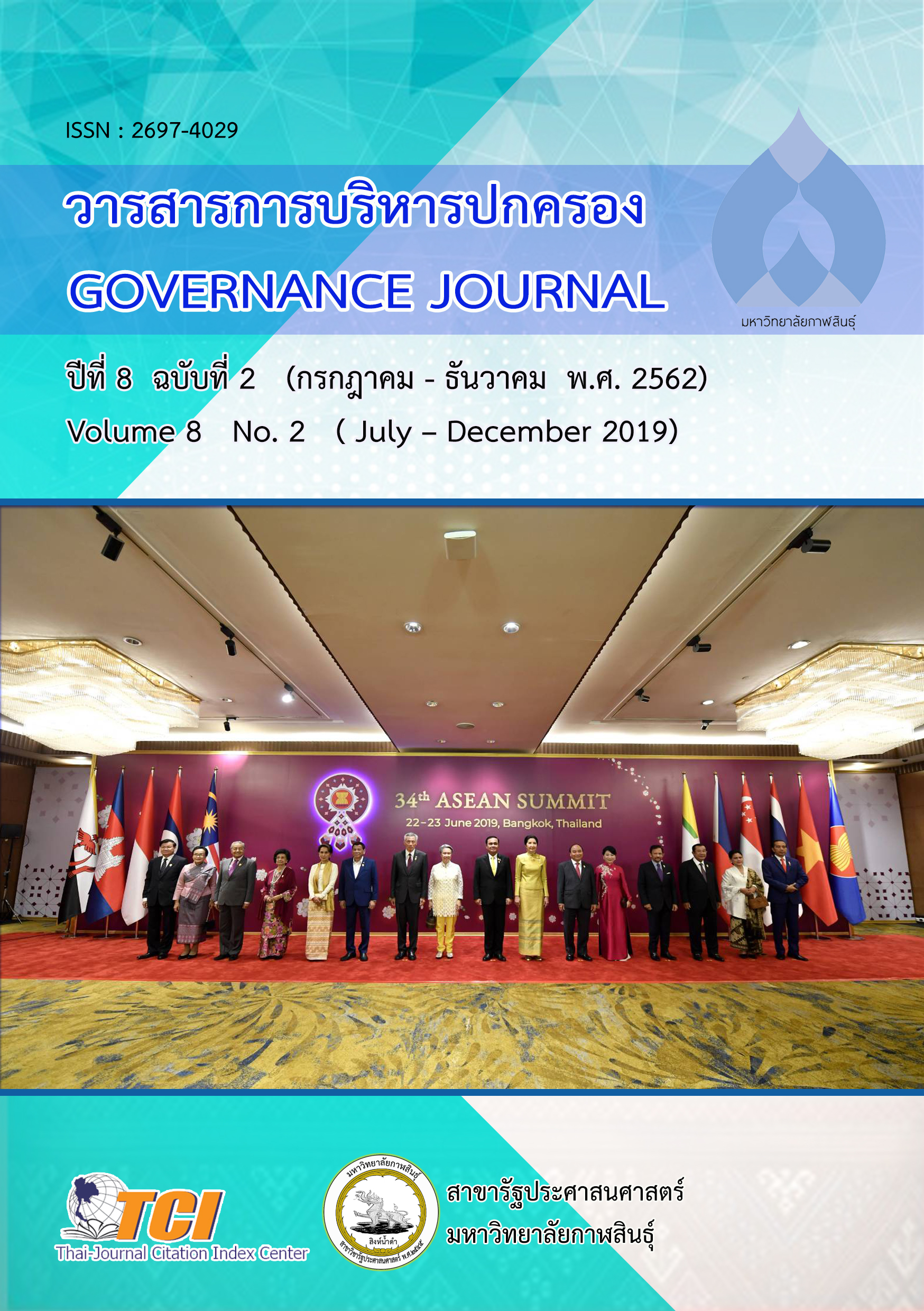การปรับตัวต่ออุทกภัยของชุมชนคูสว่าง ตำบลหนองกินเพล อำเภอวารินชำราบ จังหวัดอุบลราชธานี
DOI:
https://doi.org/10.14456/gjl.2019.40คำสำคัญ:
การปรับตัว; การจัดการอุทกภัย; จังหวัดอุบลราชธานีบทคัดย่อ
วัตถุประสงค์ของการวิจัยนี้ คือ 1) เพื่อศึกษาปัญหาและผลกระทบของอุทกภัยต่อชุมชนคูสว่าง 2) เพื่อศึกษาการปรับตัวต่ออุทกภัยของชุมชนคูสว่าง และ 3) เพื่อเสนอแนะแนวทางการเสริมสร้างศักยภาพในการปรับตัวต่ออุทกภัยของชุมชนคูสว่าง ผู้ให้ข้อมูลหลัก ได้แก่ ผู้นำชุมชน คณะกรรมการชุมชน 2 คน ผู้บริหารขององค์การบริหารส่วนตำบลหนองกินเพล 2 คน และผู้บริหารและเจ้าหน้าที่ของสำนักงานป้องกันและบรรเทาสาธารณภัยจังหวัดอุบลราชธานี 3 คน ข้อมูลถูกรวบรวมโดยการสัมภาษณ์เชิงลึก การอภิปรายกลุ่ม การสังเกต รวมทั้งการตรวจสอบข้อมูลด้วยวิธีการสามเส้า จากนั้นข้อมูลถูกวิเคราะห์ด้วยการจัดหมวดหมู่ การเปรียบเทียบ และการสังเคราะห์ ผลการศึกษาพบว่าชุมชนคูสว่างมีการปรับตัวต่ออุทกภัยทั้งในช่วงก่อน ระหว่าง และหลังเกิดอุทกภัย ข้อเสนอแนะจากการวิจัย คือ ชุมชนคูสว่างควรได้รับการส่งเสริมผ่านทางแนวทางเชิงโครงสร้างและไม่ใช่เชิงโครงสร้าง เพื่อการปรับต่อการจัดการอุทกภัย
คำสำคัญ: การปรับตัว; การจัดการอุทกภัย; จังหวัดอุบลราชธานี
Downloads
เอกสารอ้างอิง
Alaerts, G. J., Blair, T. L., & Hartvelt, F. J. A. (1991). Strategy for Water
Sector Capacity Building: Proceedings of the UNDP Symposium. Retrieved from http://www. ircwash.org/sites/default/files/202.2-91ST-9224.pdf, March 21, 2018.
Antwi, K. B., & Analoui, F. (2008). Challenges in building the capacity of
Human resource development in decentralized local governments –Evidence from Ghana. Management Research News, 31 (7): 504-517.
Archer, D., & Dodman, D. (2015). Making capacity building critical: Power
and justice in building urban climate resilience in Indonesia and Thailand. Urban Climate: 1-11.
Bradford, et al. (2012). Risk perception – issues for flood management in
Europe. Natural Hazards Earth System Science, 12 (7): 2299–2309.
Carter, W. N. (1991). Disaster Management: A Disaster Management’s
Handbook. Manila: ADB.
Hori, T., & Shaw, R. (Eds.). (2014). Elements for sustainable community-
based disaster risk, Local Disaster Risk Management in a Changing Climate: Perspective from Central America. Bingley, England: Emerald.
Jahangiri, K., Izadkhah, Y. O., & Tabibi, S. J. (2011). A comparative study on
community-based disaster management in selected countries and
designing a model for Iran. Disaster Prevention and Management, 20 (1): 82-94.
Japan International Cooperation Agency. (2008). Building Disaster
Resilient Societies. Retrieved from http://www.jica.go.jp/english/our_work/thematic_issues/water/ pdf/cooperation_01.pdf, April, 1 2018.
Katsuhama, Y. (2010). Capacity Building for Flood Management in
Developing Countries under Cimate Change (Unpublished
doctoral dissertation). Department of Civil and Environmental Engineering Colorado State University, Fort Collins, Colorado.
Lavell, A. (1999). Natural and Technological Disasters: Capacity
Building and Human Resource Development for Disaster Management. Retrieved from ipcc wg2. gov/njlite_download.php?id=6110, March 3, 2018.
McBean, G., & Rodgers, C. (2010) Climate hazards and disasters: The need
for capacity building. WIREs Climate Change, 1 (6): 871-884.
Minea, G., & Zaharia, L. (2011). Structural and non-structural measures for
flood risk mitigation in the Bâsca River Catchment (Romania). Forum Geografic, 10 (1): 157-166.
Mitchell, T., Van Aalst, P., & Villanueva, P. S. (2010). Assessing Progress on
Integrating Disaster Risk Reduction and Climate Change
Adaption in Development Process. UK: Institute of Development Studies, University of Sussex.
Newport, J. K., & Jawahar, G.G. P. (2003). Community participation and
public awareness in disaster mitigation. Disaster Prevention and Management, 12 (1): 33-36.
O’Brien, G., O’Keefe, P., Rose, J., & Wisner, B. (2006). Climate change and
disaster management. Disasters, 30 (1): 64−80.
Pribadi, K. S., Argo, T., Mariani, A., & Parlan, H. (2011). Implementation of
community based disaster risk management in Indonesia:
Progress, issues and challenges. In R. Osti, & K. Miyake (Editors),
Forms of Community Participation in Disaster Risk
Management Practices. New York: Nova Science, pp. 1-15.
Shaw, R. (2009). Earthquake risk management: Problems and prospects. In
R. Shaw & R. R. Krishnamurthy (Editors), Disaster Management:
Global Challenges and Local Solutions, chapter 2. India: CRC
Press, pp. 20-37.
United Nations Educational, Scientific and Cultural Organization. (2006).
Guidebook for Planning Education in Emergencies and Reconstruction. Retrieved from http://www.preventionweb.net/files/8401_guidebook.pdf, March 3, 2018.
United States Agency International Development. (2011). Introduction to
Disaster Risk Reduction. Retrieved from http://www.preventionweb.net/files/26081_ kp1concepdisasterrisk1.pdf, March 21, 2018.
Ulum, M. C., & Chaijaroenwatana, B. (2011). Governance and capacity
building of handling the flood issue in Bojonegoro municipality, Indonesia. Journal of Politics and Governance, 3(1), 18-34.
Victoria, L. P. (2001). Community Based Approaches to Disaster
Mitigation. Retrieved
from http://www.alnap.org/resource/7364, March 2, 2018.
White, B. A., & Rorick, M. M. (2010). Cost-benefit Analysis for Community-
Based: Disaster Risk Reduction in Kailali, Nepal. Retrieved from https://www. mercycorps.org/sites/default/files/mc-cba_report-final-2010-2.pdf, March 31, 2018.
Wongpreedee, A., & Sudhipongpracha, T. (2014). Disaster management that
works: Flood management strategy and implementation in Nakorn Pakkred Municipality. NIDA Case Research Journal, 6(1): 1-32.
ดาวน์โหลด
เผยแพร่แล้ว
รูปแบบการอ้างอิง
ฉบับ
ประเภทบทความ
สัญญาอนุญาต

อนุญาตภายใต้เงื่อนไข Creative Commons Attribution-NonCommercial-NoDerivatives 4.0 International License.








